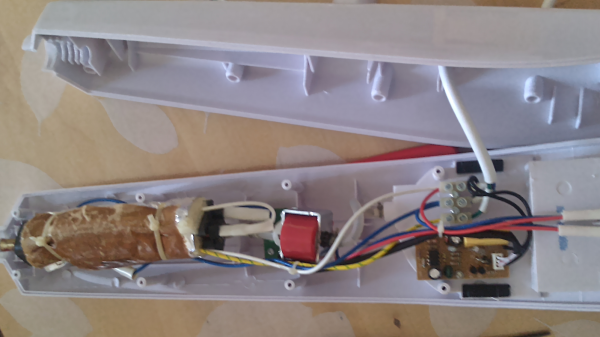“Dammit Jim, I’m a hacker, not a musician!”, to paraphrase McCoy Scotty from the original Star Trek series. Well, some of us are also musicians, some, like me, are also hack-musicians, and some wouldn’t know a whole note from a treble clef. But every now and then the music you want is in the form of sheet music and you need to convert that to something your hack can play. If you’re lucky, you can find software that will read the sheet music for you and spit out a MIDI or WAV file. Or, as with my hand-cranked music player, you may have to read just enough of the music yourself to convert musical notes to frequencies for something like a 555 timer chip. We’ll dive into both cases here.
555 timer70 Articles
Conflict Escalates Between Brilliant Rat And 555 Timer
After [Casey Connor] captured and relocated a number of unwanted rodents in his home using commercially available live traps, he was presented with a problem: a rat had learned to avoid them.
In an epic, and adorable, conflict caught on video (and embedded below), he documents the designs used and how the rat escaped them by either recognizing the trap, or sheer agility. We can only tip our hat to the determination of both parties.
All the trap mechanisms are based on a 555 monostable solenoid triggering circuit  that ensures that a pulse of sufficient duration is sent to the solenoid to trigger the trap correctly. This way even intermittent contacts will trigger the trap rather than just causing the solenoid to twitch without fully actuating. This is the same technique used to debounce a switch using a 555 timer.
that ensures that a pulse of sufficient duration is sent to the solenoid to trigger the trap correctly. This way even intermittent contacts will trigger the trap rather than just causing the solenoid to twitch without fully actuating. This is the same technique used to debounce a switch using a 555 timer.
A Raspberry Pi Zero detects motion using an IR camera to film the interesting parts. This is also a good indicator for when you’ve trapped your quarry – if you’re trying be humane then leaving it in a trap for days is counterproductive.
With the time and effort we spend building better and more complex rodent traps, we sometimes wonder who has cleverly trapped whom.
Continue reading “Conflict Escalates Between Brilliant Rat And 555 Timer”
Semi-automatic Mouse Requires No Permit
When [Kerry]’s son asked him if there was a way to make a mouse click rapidly, he knew he could take the easy way and just do it in software. But what’s the fun in that? In a sense, it’s just as easy to do it with hardware—all you have to do is find a way to change the voltage in order to simulate mouse clicks.
[Kerry] decided to use the venerable 555 timer as an astable oscillator. He wired a momentary button in parallel with the left mouse button. A 50k mini pot used as the discharge resistor allows him to dial in the sensitivity. [Kerry] found that he maxed out around 5 clicks per second when clicking the regular button, and ~20 clicks per second with the momentary button as measured here. The mouse still works normally, and now [Kerry]’s son can totally pwn n00bs without getting a repetitive stress injury. M1 your way past the break to check out [Kerry]’s build video.
There are lots of other cool things you can do with an optical mouse, like visual odometry for cars and robots.
Greet The Sun With A 555 Flute
Here’s an interesting implementation of a classic: the 555 timer as astable multivibrator for the noble purpose of making weird music. [pratchel] calls this a Morgenflöte or morning flute, indicating that it is best played in the morning. It would certainly wake up everyone in the house.
Instead of using LDRs in straight-up Theremin mode and waving his hands about, [pratchel] mounted one in each of several cardboard tubes. One tube is small and has just a few holes; this is intended to be used as a flute. [pratchel] cautions against locating holes too close to the LDR, because it will overpower the others when left uncovered. A larger tube with more holes can be used as a kind of light-dependent slide whistle with another holey tube that fits inside. We were disappointed to find that the giant tube sitting by the amplifier hasn’t been made into a contrabass flute.
Continuing the theme of astability, [pratchel] went completely solderless and built the circuit on a breadboard. The LDR’s legs are kept separate by a piece of cardboard. This kind of project and construction is fairly kid and beginner-friendly. It would be a good one for getting your musically inclined friends and family members into electronics. Here’s a 555 player piano built by Hackaday’s own [Steven Dufresne] that might be a good second step. Check out [pratchel]’s performance after the break.
555 Plasma Speaker
The 555 can do anything. OK, that’s become a bit of a trope in our community, but there is quite a lot of truth behind it: this little timer chip is an astonishingly versatile component.
[Alexander Lang] has added another achievement to the 555’s repertoire, he’s used one in the creation of a plasma speaker. Working at Hackspace Manchester, he’s used the 555 as a pulse-width modulator that drives a flyback transformer through a MOSFET, which feeds a spark gap mounted in a lasercut enclosure. The results maybe aren’t yet hi-fi, but it works, and is very audible.
We’ve been following this project for a while, as he’s updated his progress through several iterations. From initial design idea through PCB and enclosure design, to a first working prototype and some audio refinements, and finally this latest post with the spark gap in its enclosure. He is still refining his speaker, so there is more to come
In the video below the break he demonstrates his pulse width modulator, and tests the device using a keyboard as an input.
Fail Of The Week – Steam Cleaner Fix Goes Bad
[Sven337] was gifted a steam cleaner, and seemed pretty happy because it helped clean the floor better than a regular mop. Until it fell one day, and promptly stopped working. It would produce steam for a short while and then start spitting out cold water, flooding the floor.
Like any self-respecting hacker, he rolled up his sleeves and set about trying to fix it. The most-likely suspect looked like the thermostat — it would switch off and then wouldn’t switch on again until the water temperature fell way below the target, letting out liquid water instead of steam after the first switching cycle. A replacement thermostat was ordered out via eBay.
Meanwhile, he decided to try out his hypothesis by shorting out the thermostat contacts. That’s when things went south. The heater worked, and got over-heated due to the missing thermostat. The over-temperature fuse in the heater coil blew, so [Sven337] avoided burning down his house. But now, he had to replace the fuse as well as the thermostat.
[Sven337] bundled up all the parts and put them in cold storage. The thermostat arrived after almost 2 months. When it was time to put it all together, a piece of fibreglass tubing that slides over the heater coil was missing. Without the protective sleeve, the heater coil was shorting out with the grounded heater body, blowing out the fuses in his apartment.
That’s when [Sven337] called it a day and threw out the darn steam mop — a few dollars down the drain, a few hours lost, but at least he learnt a few things. Murphy’s Law being what it is, he found the missing insulation sleeve right after he’d thrown it away.
Motorcycle Headlight Modulator Is A Bright Idea
Motorcyclists are paranoid about being hit by cars, and with reason. You’re a lot safer when you’re encased in a metal shell, with airbags and seatbelts. The mass difference between a car and a motorcycle doesn’t work out well for the biker, either. Unfortunately for bikers, motorcycles are also slimmer and generally less visible than cars.
A few decades ago, motorcycle manufacturers switched over to daytime running headlights to make bikes more visible. In the meantime, however, cars have done the same, leading many bikers to fear that their visibility advantage is losing it’s impact. The solution? Blink the headlights gently during the daytime, and run them normally at night.
[William Dudley] was unsatisfied with commercial versions, so he built a custom headlight modulator for his motorcycle.
 And believe it or not, he did it with a 555 timer IC and a light-dependent resistor (plus some transistors and a whole slew of miscellaneous parts). But [William]’s design is a good one, and he walks you through all of the choices he made in building the light-sensing circuit that disables the 555.
And believe it or not, he did it with a 555 timer IC and a light-dependent resistor (plus some transistors and a whole slew of miscellaneous parts). But [William]’s design is a good one, and he walks you through all of the choices he made in building the light-sensing circuit that disables the 555.
Whether you need a motorcycle headlight modulator or are interested to learn how this problem would be solved in the pre-Arduino days, go check out [William]’s post. And while you’re on the nostalgic electronics trip, check out this nixie tube speedometer.


















